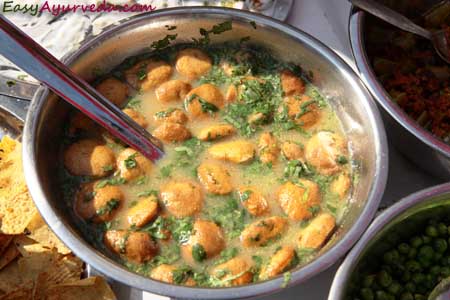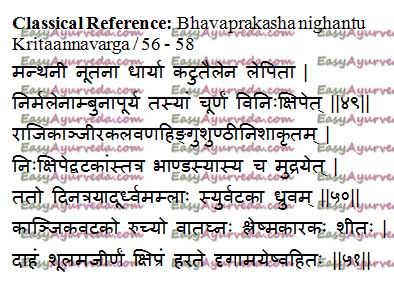Kanji Vada – Ayurvedic Method, Preparation, Health Benefits
Article by Dr MS Krishnamurthy MD (Ayu) , PhD.
Table of Contents
Introduction
Kanji Vada is an ancient Ayurvedic food recipe. Even today, this dish is prepared and relished by people of Rajasthan, Uttar Pradesh etc.
Search for new food recipes is always on. Some new food discovery may not give due attention to nutritive value, wholesomeness, hygienic factors, compatibility, digestibility, etc.
The main criteria have become taste, whether it can be mass produced in short time and and cost effectiveness. It is the reason why many Chinese food preparations are available in every street and corners of India.
Instead of this if we have a look into the depth of Ayurvedic food preparations we can find a lot of references. They are classical, authentic, wholesome, time tested, cheaper and accustomed to most of the human body types and disease conditions. However taste, texture, color, consistency and wholesomeness are variable as per one’s constitution, although the concepts of Ayurveda are being accepted worldwide.

Kanjika vada – sour gruel dipped Vada/ Kanji Bada (Hindi) is one such recipe which is explained in Bhavaprakasha text, even though appears new for the time, it has several health benefits.
Classical reference

Classical Reference: Bhavaprakasha nighantu – Kritaanavarga / 56 – 58
Method of preparation
A new and sufficiently large earthen vessel (Handi) is taken and the inner side is smeared with mustard oil. This is filled with clean and potable water. Further, fine powder of mustard, cumin seeds, rock salt, asafoetida, ginger and turmeric is added, mixed and kept for few minutes.
Fresh Vadas prepared out of black gram are placed in this (immersed/soaked) and the mouth of the vessel is closed. After 3 – 4 days when the whole content becomes sour, the lid is removed and inner content is collected.This is called Kanjika vada.
Even today in Rajasthan, UP and Gujarat this kind of food is practiced in traditional houses.
Read related: Medu Vada: How to Make? Ayurveda Benefits
Qualities
Ruchya (appetizer),
Balances Vata Dosha,
Increases Kapha Dosha
Shoolahara (analgesic, anti spasmoidic) and
Deepana (carminative).
Useful in bloating, low digestion strength.
Indications
This can be practiced in the individuals who have indigestion, anorexia, repeated colic pain, distention of abdomen etc.
Caution should be taken to avoid this food recipe in the individuals who are suffering from severe eye diseases and acid peptic disorders.
A food with classical evidence, age old practical knowledge and wholesome features! Can’t we adopt such new tastes in day to day practice instead of food and beverages which are not familiar and less known about their compatibility!
Click to consult Dr MS Krishnamurthy MD(Ayu), PhD.









